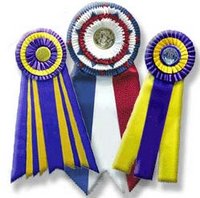 [Permission to cross post. Also see: this related story ]
[Permission to cross post. Also see: this related story ]
Following the signing of a contract with puppy-mill distributor Petland, the American Kennel Club has begun to feel the heat.Odds are still 7 to 3 that nothing will come of the protests (the AKC staff does not give a rat's ass what the breed clubs say), but there have been some small bursts of eloquence, nonetheless.
Former AKC Board member and current AKC judge Patricia Laurans (an eight-time Westminster judge)
told the AKC Board (click on link for PDF of AKC Board Meeting minutes):
"I would like to call attention to every single Parent clubs’ that I know of code of ethics that says we will not sell to pet stores.
"I would like to call attention to the fact that, from my humble belief, we are selling our birthright for a few shekels.
"I would like to call attention that this is a club of clubs and that we are your constituency. We are the groups that are asked to help out with medallions, to work at shows, to educate the public, to make our clubs and our events more friendly so we can help increase registration on a volunteer basis.
"I would like to make note of the fact, and pardon me, I feel we are prostituting some of our values, I feel we are going against what I believe most of the members and member clubs would want to see happen, and I feel that we should have at least had some sort of way to give you our thoughts before contracts were signed, sealed and delivered. You said, and I supported the fact, that we don’t want to let the enemy in. I question the fact right now if the enemy is already here."
What was the reaction of the AKC hierarchy to this speech? Basically, they patted Ms. Laurans on the head, told her she was a naive fool, and asked her to shut up.
For example, Steven Gladstone, who is on the current AKC Board, said:
"With all respect, Pat, we have been taking their money for 75 years and cashing their checks....we have got to accept the fact, we are taking their money; and, yes, ... we are endorsing them with our papers. We are telling the world these people meet AKC standards. Now, you may not like that, but the fact is that we have lived off of that for the last 60 years."
David Merriam, Vice Chairman of the AKC Board of Directors, said:"What has changed is that we have competitors, and these competitors now are in the pet stores. They’re in the commercial channels. And they say, 'Okay, it costs $15 to register a puppy, XYZ Registry will do it for $12, and we’ll kickback three dollars to the pet shop.' That’s the competition we’re in, and don’t believe that it hasn’t had an effect on our registration.
Every meeting, Jim Stevens relates the decline of our registration. If we are going to address this in a serious, honest and a realistic way, we have got to address that segment of the registration. That is the commercial. And that’s simply the answer.
If you want to tell the Board and your fellow clubs that we are willing to go inward, support ourselves, pay the price, then that’s a direction you can go. But I think if we go that direction, the American Kennel Club will not exist 100 years from today."
Bottom Line:What the breed clubs think has as much chance of shaping the AKC as rain water on a stone.
And besides, what are the breed clubs going to do, resign?It would not matter to the AKC if they did. Look at the Border Collie and the Jack Russell Terrier to see what the AKC does if an existing breed club will not drink the toxic Koolaid being offered up. In both cases the AKC simply went out and recruited an ego-hungry group of fools to start a new breed club that was more than ready and willing to follow AKC staff direction.
At this point in the game, registrations and money wag the dog in the AKC, and the breed clubs have little or no control over what the AKC does.
And from the AKC staff's perspective, why should they? After all, it's not like the AKC breed clubs are a major financial engine within the organization.
In fact, from a purely cash-and-cost point of view, the breed clubs are revenue calfs sucking money out of the AKC -- a
lot of money
The folks paying the bills -- the cash cows producing most of the milk -- are the dog breeders who are not members of breed clubs, and whose canine philosophy can be boiled down to two short sentences: "Puppies are cute," and "I clear $3,000 a litter."
Of course the AKC is no better than these a cash-and-carry dog breeders. For them too, a litter of dogs is nothing but a profit center.
As for the Board of the AKC, they appear to be led by idiots. Business plans are not supposed to be 100 years long -- not even the Chinese think like that. Nor is the "Big Box Store" the best business plan model for the AKC. When people purchase a dog, they are not supposed to think of the animal as a bulk commodity, like beans and rice, but as a one-off purchase of a thing of
quality. But that point of view is apparently not shared by the current Board of the AKC which voted 12-to-1 in favor of the Petland contract.
In truth, the AKC has fallen down a manhole. For as long as I can remember, their focus has not been on doing the right thing for dogs, but on keeping the money flowing.
Mr. Merriam, it appears, is more than willing to sacrifice principle and prestige to keep the Club going, but he is not willing to remake the AKC so that it is an organizaton identified with high-quality healthy dogs able to engage in performance functions. And above all, he is not willing to tender the idea of the AKC ever going out of business.
It seems that in the struggle to keep the doors open at the AKC, certain things can be discussed (like endorsing puppy mills), but others cannot (like moving out of their Madison Avenue digs in New York City in order to save millions on rent and salaries). The AKC Board of Directors and staff are willing to sacrifice dogs for cash, but they are not willing to tuck in the belt or pack up the bag for a move to Minnesota.
This is not to say that the AKC staff and Board of Directors do not have a clear view on some things. They are clearly right when they say the folks in the breed clubs are naive. After all, the AKC
has been sucking on the puppy mill teat for more than 60 years - - on this point, nothing has changed.
Nor has this information been closely held: just
"google" AKC and "puppy mill" and see how many hits you get.
Nor is the only AKC problem the "big wink" of puppy mill money. No one in the world of dogs can have possibly missed the genetic decline in dogs that has occured over the course of the last 60 years. The causal reason here is that the AKC and show ring
afficionadoes continue to embrace the failed eugenics theories of the 19th Century (see
Inbred Thinking for more on this topic).
And so we get down to it now, don't we? Will the AKC representative of the Border Terrier Club of America resign in protest and will the Border Terrier Club disenthrall itself from the AKC? Will it matter if it does? How about the representatives of the Parson Russell Terrier Association of America? What will it do? How about all the other breed clubs?
My bet is that the Board of Directors and staff of the AKC are betting right in their calculations.
In the end, most breeders and show ring enthusiasts in AKC breed clubs will lower their heads and shuffle forward like cattle. They have always done so in the past. A few dozen may bawl and mew, and one or two may even jump the fence, but it's a big country and the AKC will replace them quickly and move forward.
In truth, I think very few people will make a stink.And why should they? After all, the AKC is simply doing what it has always done. In for a penny, in for a pound.
It would be silly for anyone in the AKC quit over the Petland deal because, as AKC Boad of Directors Chairman David Merriam notes, all the AKC is doing now is telling the truth and putting their ethics in the front window for all to see. Anyone who quits now is quiting not because of
the practice of taking cash and doing business with puppy mills, but because they are
embarassed at being seen as part of the deal.
To which I can only advise: "Don't do things you are ashamed of." But then,
I am a bit of a Puritan, aren't I?.
As for the AKC, their longterm business plan is not much of a secret. The AKC has teamed up with the Humane Society of the United States and PETA to push for legislation mandating the microchipping of all pets. This is a great idea as far as the AKC is concerned, as they happen to own one of the most popular microchip products around.
PAWS legislation would, in effect, be a multi-million dollar subsidy for the AKC.
The AKC is also getting into the heath care and insurance business -- two notoriously crooked arenas. The AKC figures it will be able to make many millions of dollars in kickbacks from veterinarians, while the veterinarians will get a steady supply of gullible customers -- a win-win for everyone but the consumer.
Gilding the lilly is the fact that the AKC will have a steady stream of veterinarians willing to speak up and testify on the AKC's behalf should a reporter come poking around asking hard questions. The veterinarians, in turn, will give the AKC their "seal of approval" (doctors are generally trusted by the public), while the AKC will give the veterinarians their seal of approval (after all, who is better qualified to "certify" a veterinarian than the AKC?).
At the same time that all this is going on, the Humane Society, PETA and other lunatic fringe "animal rights" groups have been successfully pushing legislation that would require all non-show dogs to be neutered or spayed. These laws are ostensibly designed to reduce the number of "unwanted" puppies in America, and mandatory spay-netuer laws have already been embraced in Los Angeles and San Francisco, and are under consideration in places as diverse as Sacramento, New Jersey, and Virginia.
Is it just a coincidence that these mandatory spay-neuter laws will have a very positive benefit for the AKC? After all, if enough of these laws are passed, the end result will be that almost every dog in America will come from a show breeder (most of whom will be affiliated with the AKC) or a commerical breeder (with whom the AKC will have a licensing contract).
How perfect is that?The AKC says it opposes mandatory spay-neuter laws, but their opposition has been pretty tepid as far as I can see. In truth, I suspect the AKC is simply on the road to another "Big Wink" in which they profess to oppose something (like puppy mills) even as they maneuver to make more money from the "inevitable" (like puppy mills).
Like Brer Rabbit they warn, "Don't throw me into that briar patch."
 Why are all of these shenanigans necessary?
Why are all of these shenanigans necessary? To put it simply, this puppy-mill seal of approval scheme is necessary because the American Kennel Club is producing a product fewer and fewer people are willing to buy. The secret is out that Kennel Club dogs are no better than any other kind of dog.
In fact, due to the Kennel Club's long embrace of inbreeding and line breeding, AKC dogs may be
less healthy than a cross bred dog collected from the pound.
Failing businesses are insidious places because owners and managers are so often willing to do unethical things in order to try to stay afloat. In a failing church the pastor may torch the building for the insurance money. In a failing dry cleaning business, the proprietor may report only a portion of his income to the IRS. At a failing construction company, the owner might stop making OSHA-required safety improvements or stop paying into the pension fund. And, of course, at the AKC you end up endorsing the puppy mill industry and price-gouging veterinarians.
From the point of view of the AKC Board of Directors, of course, "something" had to be done to bring in more money. After all, the Club is only running a net profit of $5.7 million a year. Clealy what is needed is more money, more money, more money.
The problem is that while are a thousand and one ways to spend money at the AKC (an expensive building on Madison Avenue, an expensive New York City staff, a magazine that no one reads, lawyers and lobbyists, lots of travel, etc.), there are precious few ways to raise revenue.
Forget the dogs shows -- they consume money (a $10 million loss in 2005), they do not produce it. Behind every AKC rosette is puppy mill dog making that rosette possible. Say what you will, but the AKC is not givng up those rosettes.
The show must go on.Which leaves us with the central dilemma faced by the AKC Board: How to "make the nut" from year to year.
A core element in the AKC solvency scheme has always been to mass-produce registrations for mass-produced dogs. And
really, the AKC is not doing anything different now than what it always has.Sure it's a bit of a leap in the dark and a calculated risk that there will not be a mass exodus of dog breeders from the AKC's roles.
But the AKC has done the math, and they know their audience and their business. That audience is human, not canine, and the business is ego, not better-bred dogs.
And so, when the day is done, I expect a small flury of outraged mewing and bawling from the cattle, but in the end most will march smartly through the gate at their next AKC show.
Sure a few old cranky's will walk away in a huff, but so what? The AKC is a business, and the bottom line is the bottom line.
In a few years the Petland deal will be seen as a "normal" thing, and the new cattle coming into the feed lot will pay it no mind, while the AKC itself will be able to "keep on keeping on" -- Madison Avenue offices, inflated salaries, and puppy mills profits as usual.
 ,
,

























